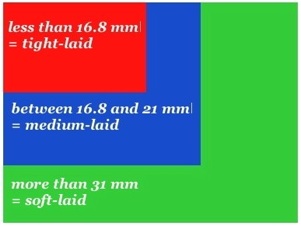The Length of Lay

Choosing a length of lay for your ropes
(bunched strands)
Hard-laid rope feel a bit heavier than medium and soft laid ropes, as more material is used for identical length of the finished product.
It can also feel stiffer, but that may also depend on the quality of the fibres used and the way you prepare and condition your ropes.
Contrary to what you might expect, this type of rope is not as strong as soft-laid rope. The reason is that the tighter the yarns are twisted, the closer they get to their breaking point.
A hard-laid rope has also more elasticity, so it will stretch more under load than a softer-laid one.
On the positive side, a hard-laid rope will be more resistant to damage due to dirt and will not absorb humidity as fast and deeply as soft-laid rope - although it will, to some extent, as we’re dealing with natural fibres which are anything but hydrophobic. *
Soft-laid rope is lighter as it uses less material. It is also softer to the touch, more flexible, and stronger than hard-laid rope.
The main drawback is that it is more fragile to handle, and for instance it can snag more easily, or develop high-stranding (more on high-stranding here).
It will also be more sensitive to dirt, dust and other external elements as the strands can open more easily.
Those ropes are a better choice for suspension main lines than hard-laid ropes.
They also hold knots better than stiffer rope.
Medium-laid rope offers thus a good option, giving you a bit of both worlds, so to speak.
The length of lay determines the tightness of the rope
A rope can have a short, medium or long/soft lay.
The values below apply to 6mm diameter rope made with bunched strands (= no core in the strands).
To measure the length of lay, you can either measure the angle of the strands, or the distance required for a strand to complete a full revolution, as shown below:
When you make strands with a core, those values are not relevant, due to the difference of strand structure. The photo below shows a Japanese 6mm diameter rope. Although its length of lay is superior to 21 mm, it should not be considered to be a soft-laid rope, but rather as a medium-laid one.
For more information on the characteristics of Japanese ropes, see here
To go back to “Steps”, click here




* One way to make ropes a litlle more hydrophobic is to regularly oil/wax them.